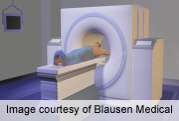In patients undergoing computed tomography colonography, reducing the tube voltage from 120 kVp to 100 kVp significantly reduces radiation dose while minimally reducing image quality, regardless of patient size, according to a study published in the March issue of Radiology.
(HealthDay)—In patients undergoing computed tomography (CT) colonography, reducing the tube voltage from 120 kVp to 100 kVp significantly reduces radiation dose while minimally reducing image quality, regardless of patient size, according to a study published in the March issue of Radiology.
To examine the effect of a decrease in tube voltage from 120 kVp to 100 kVp in patients undergoing CT colonography, Kevin J. Chang, M.D., from Rhode Island Hospital in Providence, and colleagues compared radiation dose, contrast-to-noise ratio, and three-dimensional image quality in 63 patients undergoing CT colonography, with scanning performed in the supine (120 kVp) and prone (100 kVp) positions.
The researchers found that reducing the voltage reduced the volume CT dose index by 20 percent and reduced the dose-length product by 16 percent. There was a 32 percent increase in image noise and an increase in mean attenuation of tagged fluid from 395 to 487 HU, but no net change in the contrast-to-noise ratio of tagged fluid, regardless of patient size. On a scale of 5, image quality fell to 4 from 5.
"A decrease in tube voltage from 120 to 100 kVp results in a significant decrease in radiation dose but only a minimal decrease in three-dimensional image quality at all patient sizes," Chang and colleagues conclude.
One author disclosed financial ties to Siemens; another author is an unpaid consultant to GE Medical Systems.
More information:
Abstract
Full Text (subscription or payment may be required)
Journal information: Radiology
Health News Copyright © 2013 HealthDay. All rights reserved.


















